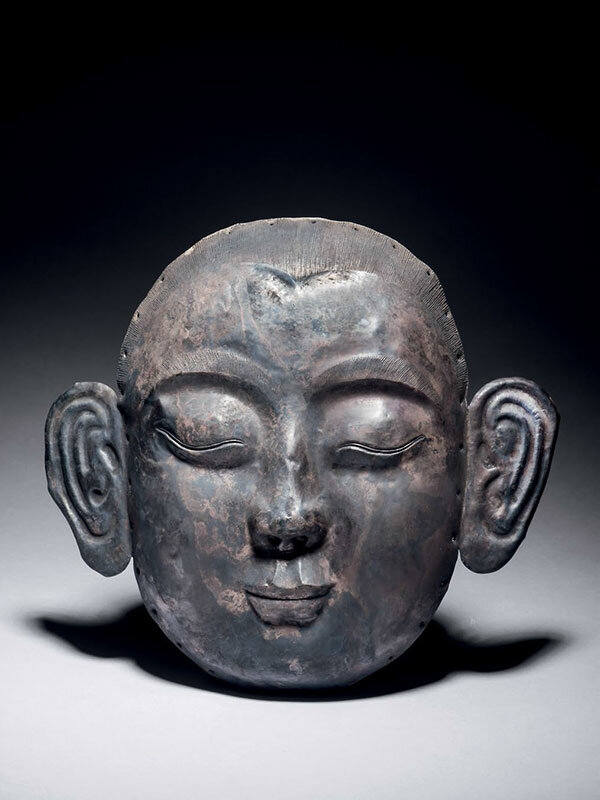Silver funerary mask, China, Liao dynasty, 10th-11th century
Silver funerary mask, China, Liao dynasty, 10th-11th century. Length: 8 3/8 inches, 21.2 cm. Width: 9 1/8 inches, 23.1 cm. © Ben Janssens Oriental Art
A silver funerary mask depicting a human face, worked in repoussé technique with strong, naturalistically portrayed features and a demure expression. The heavy-lidded eyes are shut and set below pronounced, arched eyebrows that are engraved with fine lines in parallel. The face has high cheekbones and a straight, broad nose set above a full-lipped, well-defined mouth. The finely detailed, prominent ears jut out to either side of the head. The edge of the face is surrounded by small holes. The silver is extensively patinated.
Masks such as the present example are thought to be the products of shamanistic religious beliefs, and are said to accurately reflect the facial features, age and sex of the interred. The row of tiny holes around the edge of the mask indicates that it was once attached to a wire mesh, which encased the entire body of the deceased, including the head. This funerary practice is specifically associated with the Qidan (Khitan), a semi-nomadic tribe of hunters and pastoral people, who founded the Liao dynasty that governed northern China from 907 – 1125. The material used for the funerary mask was determined by the status of the wearer; copper was used for those of lowly rank, high-ranking officials were allowed to have silver and silver gilt masks, and gold was reserved for members of the imperial family. [1] A unique gold funerary mask with silver netting still attached, excavated from the tomb of the princess of Chen and made for the burial of her husband Xiao Shaoju, is now in the Research Institute of Cultural Relics and Archaeology of Inner Mongolia. [2] A gilt-copper mask is in the Meiyintang collection. [3]
- Shen, Hsueh-man ed. Gilded Splendor, Treasures of China’s Liao Empire (907 – 1125), Asia Society New York, 2006, p. 100
- Shen, Hsueh-man ed. op. cit. no. 6, pp. 108-9
- Krahl, R. Chinese Ceramics from the Meiyintang Collection Volume One, Azimuth Editions, London 1994, fig. 31, p. 107

/https%3A%2F%2Fprofilepics.canalblog.com%2Fprofilepics%2F1%2F0%2F100183.jpg)
/https%3A%2F%2Fstorage.canalblog.com%2F03%2F02%2F119589%2F96711876_o.jpg)
/https%3A%2F%2Fstorage.canalblog.com%2F11%2F31%2F119589%2F94773502_o.jpg)
/https%3A%2F%2Fstorage.canalblog.com%2F20%2F83%2F119589%2F94772815_o.jpg)
/https%3A%2F%2Fstorage.canalblog.com%2F26%2F72%2F119589%2F75604929_o.jpg)
/https%3A%2F%2Fstorage.canalblog.com%2F59%2F60%2F119589%2F26458628_o.jpg)



/http%3A%2F%2Fstorage.canalblog.com%2F05%2F64%2F119589%2F128523518_o.jpg)
/http%3A%2F%2Fstorage.canalblog.com%2F78%2F46%2F119589%2F127133605_o.jpg)
/http%3A%2F%2Fstorage.canalblog.com%2F99%2F82%2F119589%2F126892955_o.jpg)
/http%3A%2F%2Fstorage.canalblog.com%2F51%2F84%2F119589%2F122518624_o.jpg)